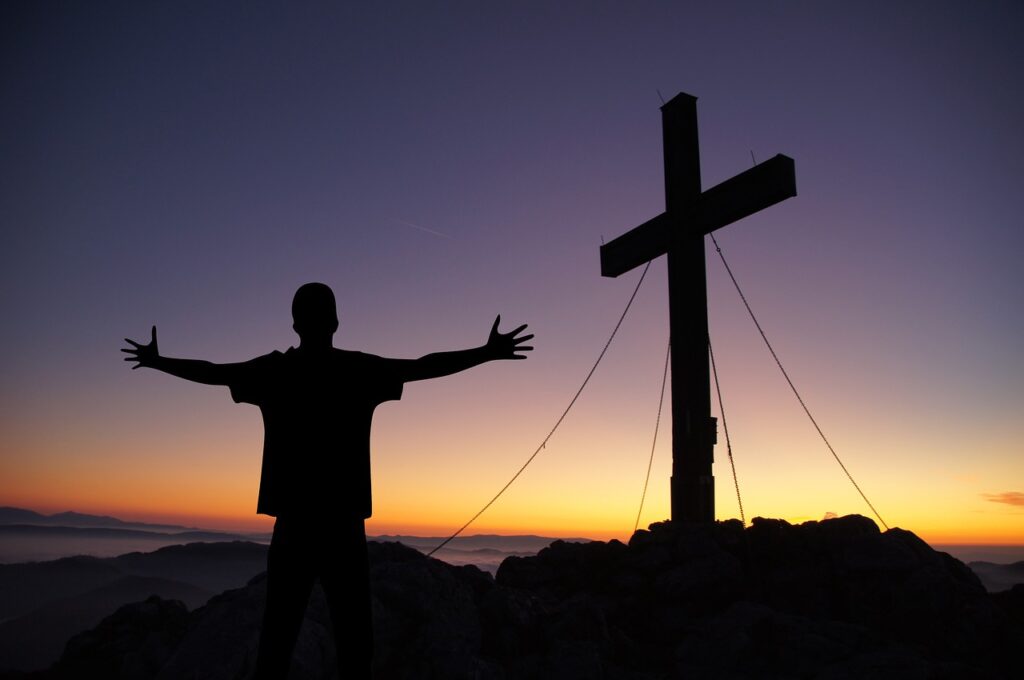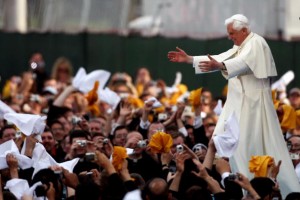One could almost feel sorry for the Roman Catholic Church. Accustomed to centuries of control over the hearts, minds, and pocket-books of ignorant flocks the world over, they now find themselves humiliated by child-abuse scandals in seemingly every diocese and must watch helplessly as their congregations dwindle. Particularly in the West and among the young, the Church has a serious image problem, not the least of which is its (accurately) perceived intolerance against non-standard sexual orientations. Nonetheless, the Church remains an inordinately powerful institution, especially in the developing world, where its rigid proscriptions against contraceptives contribute to unsustainable population growth, perpetuating human poverty and environmental destruction. So I feel no compunctions in holding the Church up for further ridicule by discussing its war against the New Age.
In 2003, the Church released a study entitled A Christian Reflection on the New Age, which identified New Age practices as fundamentally incompatible with Christianity. While earlier reports had sought to dissuade Catholics from dabbling in eastern religions, this new document identified threats in a wide range of practices, including meditation (unless done the “right” way to commune with God), yoga, feng shui, homeopathy, acupuncture, the Gaia Hypothesis, and even twelve-step programs. The Southern Baptist Convention in the U.S. largely agreed, and is therefore an equally deserving recipient of the scorn that is about to follow.
Quite rightly, the Church has acknowledged that many people no longer find their spiritual needs met by Catholicism. For the Church, this is a marketing problem of perhaps more fundamental scope than even the pedophiles (and their enablers) among its hypocritical ranks, for it portends a mass exodus of customers away from their product. They are losing market share, they know it, and they’re running scared. Perhaps they should pray a little harder?
From Dualism to Oneness
If there is one issue that seems to really stick in the Church’s craw, it is the New Age concept of divinity or spirit in all things. New Age practitioners commonly speak of “the Universe” as an all-embracing spiritual concept, and see people as integral parts of this larger whole. Though we may appear to be separate entities, we are in fact connected to all that is – to all other life and to all matter – and commune with it across space and time. For many New Age thinkers, there is no life and death but simply a flow of energy from one state or form to another. And with this understanding of universal connectivity comes a knowledge of how we create our own realities by directing energy wisely or poorly.

It is not too difficult to see how radically this spiritual view differs from that of the Church. Gone is the distinction between Creator and creation, between spirit and matter, and even between good and evil. There is no mention of heaven or hell; if anything, they are realities right here and now. And there is certainly no judgment from a vengeful God eager to punish those who transgress his code. If wisdom is contained within the fabric of the universe and potentially accessible to all just by virtue of being alive, then the Bible is clearly just a book and the Church, as self-appointed interpreter thereof, loses its ostensible raison d’etre.
The Church dismisses all of this as “weak thinking” that encourages people to place false hopes in “magic.” And it contends that the words of man are being dressed up as divine knowledge (which John Paul II saw as a reprise of “gnosis,” by which he meant occult or esoteric wisdom). The degree of cognitive dissonance here is spectacularly hilarious. The Church sees no “weak thinking” in its doctrine of transubstantiation, which teaches its worshipers that the bread and wine they taste at the Eucharist are the body and blood of Christ. It sees no “magic” in preaching about alleged miracles or in encouraging people to pray to an imaginary friend (or two) in the hope that they will be judged favorably and spend an eternal afterlife in an idyllic dreamworld. It sees no “gnosis” in expecting people to believe that a book of fairy stories written by human authors – who frequently lied about their true identities and were motivated by a desire to control social developments of which they disapproved – is the revealed word of God. And it sees nothing evil in propagating anti-scientific, medieval ignorance centuries after its sell-by-date, despite the devastating human and environmental costs.
A Monopoly of Irony
The ultimate expression of the Church’s arrogance, of course, is its assertion of monopoly power. It has absolutely, positively no problem appointing itself as the sole interpreter of the only legitimate truth, a position that rather conveniently confers upon it massive power in the temporal world. It is perhaps the most supreme irony of all, therefore, that this historical apogee of top-down bureaucracy has the chutzpah (repeat after me, Michele Bachmann) to complain that the New Age encourages adherence to what it derisively termed “enlightened masters.” Now, I suppose in the Vatican one must comport oneself as if the Protestant Reformation never happened, but didn’t someone on the committee remember that this was part of Martin Luther’s problem with the papacy? (In rejecting papal authority, Luther went so far as to call the Pope the Antichrist because he was enforcing a substitute religion featuring a cult of saints that rivaled the centrality of Christ himself.) Protestants who would seek to differentiate themselves on the grounds that the Reformation encouraged people to read the Bible for themselves, rather than relying on papal interpretation, ought to take a good, hard look at their megachurches run by Bentley-driving pastors.
Perhaps, in a future United States, Southern Baptists will be afraid that a presidential candidate will take orders from Deepak Chopra, just as they worried in 1960 that JFK would have to follow the edicts of the pontiff. But such talk is utter nonsense. The New Age movement takes the best part of the Reformation – the individual quest for truth – to a new level, encouraging each one of us to engage with our inner and outer realities in a way that both enlightens and fulfills us far better than any power-hungry priest ever could.
Meanwhile, On The Eastern Front….
Arguably the stronger and more important challenge to the New Age movement does not come from the churches at all. The fighting is much grittier and nastier on the second front, where cold blasts of self-righteous logic seek to blow away anything that does not compute. It is a matter of no small interest that the increasingly vocal atheistic community is just as hostile toward the New Age as it is toward the Catholic Church (or any other religion). Indeed, strict materialists make a point of ridiculing people who describe themselves as “spiritual but not religious.” For them, “New Age woo” is every bit as unscientific and superstitious as expecting the Rapture to happen next week.
This seems to be a matter of doctrinal consistency. Atheists don’t think they can assail religion without simultaneously attacking anything else that doesn’t agree with their model of reality. But, as a matter of tactics, this stance represents a rejection of the battle-hardened rule that “the enemy of my enemy is my friend.” It would seem that either they don’t feel they need any allies in their war against religion, or they don’t want allies like us.
These materialists would laugh if I said I shared their belief in the scientific method of testing a hypothesis through repeated experimentation. The reason they won’t talk to us is because they insist this experimentation be conducted in a lab and be subject to peer review. But in matters of personal reality, we are the lab. If I observe over many years that a particular pattern of thought or emotion leads to certain kinds of experiences in the physical world, I have myself a working hypothesis. But there is absolutely no way that you or anyone else can test it, because you can’t lay out the contents of my mind/heart/soul on a stainless-steel bench. You could, if you were willing to try, engage in a similar personal experiment yourself, but only you would be able to assay the results.
Apart from the fact that this personal testing is, not to put too fine a point on it, bloody difficult, it is a conventional scientist’s nightmare because it opens the door to countless, potentially conflicting results. Nonetheless, if a sufficient number of otherwise intelligent (!) adults all engaged in broadly similar tests and reported broadly similar results, could we be comfortable asserting that we have verified a hypothesis? This need for science and the contemplative arts to work together is a recurring theme on this blog, and I applaud those scientists who are willing to bridge that gap. But I am under no illusions about the width of the divide.









